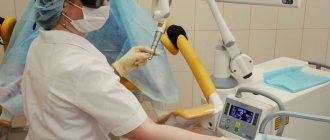Error in biopsy
A sample of the collected tissue for subsequent histological analysis can be obtained by a variety of methods that exist within the framework of minimally invasive surgery. So, during a puncture type of biopsy, the material is taken through a tube and a needle with a cutting edge. It is worth remembering that the required volume of biopath cannot always be filled into a syringe, and accordingly, the result obtained may be negative. Therefore, there is a need to repeat the biopath sampling.
If it is not possible to completely remove the tumor, doctors excise part of it. But even in this case, there may be an error in the diagnostic results, since the sample taken may differ from the bulk and volume of the tumor. Thus, total removal of the tumor is an accurate diagnostic method in this case.
Biopsy errors and main causes
In the case of conducting histology of a collected biopath, errors are possible and the main reasons that lead to them, doctors name the following:
- The location for the puncture with the needle is incorrectly selected. In this case, the biopsy instrument does not penetrate deep enough inside; only a superficial biopsy is taken from the affected area. This sample cannot fully show the clinical picture of the pathological process.
- It is impossible to take a sufficient amount of biological material for analysis from the tumor site - most often this happens due to the growth characteristics of the tumor.
- In case of violation of the rules for the collection and subsequent storage of biological material.
- Also, the error may be a consequence of incorrect technology, non-compliance with the rules and stages of preparation for subsequent examination of the collected biopath.
- The reason for the error may also lie in the low level of qualifications of the doctor conducting the biopath examination itself and the insufficient qualifications of the physician interpreting the laboratory tests obtained.
The results of the biopsy can also be influenced by the medications that the patient took on the eve of the collection of biological material. But for the most part, errors do not occur when examining a biopath and interpreting diagnostic results, or its percentage is minimal and cannot affect the outcome of the entire diagnostic process.
21.09.2018
Free consultation with a urologist
The results of histopathological examination allow the doctor not only to confirm or exclude prostate cancer, but also to establish the extent of cancer, the stage of the malignant process, choose treatment tactics and assess the prognosis of the disease. It is important for the urologist to know the exact location and extent of the pathological process. This information can help in deciding the extent of prostate surgery or in determining the biopsy site for repeat site-specific biopsy.
Pathological aspects: number, location and length of prostate tissue columns Numerous studies conducted in the USA and Europe confirm the fact that sextant prostate biopsy often gives false-negative results. According to the recommendations of the European Association of Urology, a biopsy is currently performed from at least 8 points, and additional tissue columns are taken from hypoechoic zones detected during ultrasound examination, located on the periphery of the prostate gland. Thus, during a prostate biopsy, 10 tissue columns are obtained (sextant biopsy + 2 tissue columns from the peripheral zone of each side of the prostate gland).
The length and diameter of the tissue columns are important to ensure sufficient biopsy material for histopathological examination. The length and diameter of the tissue pieces directly depend on the type of needles used and the skills of the operating urologist, however, the minimum length of the tissue column should be 15 mm, and the diameter should be 2 mm.
The material obtained from the biopsy is sent to the laboratory for histopathological examination. According to the recommendations of the European Association of Urology, pieces of tissue obtained from different parts of the prostate are sent to the laboratory in separate tubes.
The biopsy material undergoes special processing (fixation, cutting, staining), after which it is examined by a histologist under a microscope.
Histopathological examination of biopsy material
The results of a prostate biopsy must be unequivocal, i.e. crisp and clear and concise. It follows that the histopathological nomenclature of prostate lesions should be unified. Terms and phrases such as “glandular atypia,” “possibly malignant,” or “possibly benign” are not acceptable when interpreting histopathologic findings. The completeness and sufficiency of the biopsy material is of great importance for an adequate histopathological examination. An ineligible sample is one that contains little prostatic epithelial tissue. Columns of tissue, in which there is a sufficient number of prostatic epithelial structures, make it possible to distinguish a benign neoplasm from a malignant one with high accuracy. It is also necessary to know that some benign neoplasms can mimic prostate carcinoma. Taking into account the above, the European Association of Urology has adopted the following diagnostic terms used to interpret the results of prostate biopsy:
- Benign neoplasm /absence of cancer: this includes pathological findings such as fibromuscular and glandular hyperplasia, various forms of atrophy, such as foci of chronic (lymphocytic) inflammation.
- Acute inflammation , a negative result of the presence of a malignant neoplasm, is characterized by damage to glandular structures, and may explain the increased level of prostate-specific antigen in the patient.
- Chronic granulomatous inflammation , negative for malignancy: characterized by xanthogranulomatous inflammation. This condition can cause a persistent increase in prostate-specific antigen levels and give a false-positive result on digital rectal examination. As a rule, granulomatous inflammation of prostate tissue is associated with a history of BCG therapy for bladder cancer (intravesical therapy with bacillus Calmette-Guerin - a weakened strain of Mycobacterium tuberculosis).
- Adenosis/atypical adenomatous hyperplasia , negative for malignancy, is usually a rare finding in the peripheral zone of the prostate, characterized by a cluster of small acini surrounded by single basal cells.
- Prostatic intraepithelial neoplasia (PIN). PIN can be diagnosed only by histological examination, has no specific clinical manifestations, and does not cause an increase in the level of prostate-specific antigen. Initially, low-grade and high-grade PIN were distinguished; currently, it is customary to distinguish only high-grade PIN, since the diagnosis of low-grade PIN does not have prognostic value for assessing the risk of prostate cancer with a repeat biopsy.
| Diagnosis | Prostate cancer risk |
| Low degree PTS | 18% |
| Benign neoplasm | 20% |
According to the recommendations of the European Association of Urology, there are:
- High grade PIN , negative for adenocarcinoma. High-grade PIN diagnosed by extended prostate biopsy (>8 tissue cores) is not associated with an increased risk of prostate cancer and does not require a repeat biopsy. A repeat biopsy is recommended 2-3 years after the initial prostate biopsy.
| Biopsy | Prostate cancer risk | |
| High PTS | Benign neoplasm | |
| Sextant | 24,9% | 18,4% |
| Extended | 16,1% | 12,7% |
- High-grade PIN with atypical glands , suspected of adenocarcinoma. Requires a repeat extended prostate biopsy.
- A focus of atypical glands/nodule with suspected adenocarcinoma . This diagnosis is made when a histologist under a microscope sees dubious, unclear signs of cancer and cannot confidently say that it is adenocarcinoma. Such a histopathological picture can be produced by various lesions of the prostate gland, for example, a benign neoplasm simulating cancer (atrophy, basal cell hyperplasia), atypia caused by an inflammatory process, etc. A node suspected of cancer is detected in 0.7-23.4% of biopsies, and The risk of prostate cancer with a repeat biopsy is 41%.
- Adenocarcinoma.
If a diagnosis of adenocarcinoma is made, the histopathological type of tumor (small acinar, papillary, etc.) must be indicated; it will also be important for the clinician to know how many positive tissue columns were detected during the study and their location. The histologist must indicate in millimeters the extent and percentage (%) of the tumor in each tissue column, which will allow assessing the prevalence of the malignant process, choosing treatment tactics and determining the prognosis. According to the European Association of Urology, the extent and percentage of tumor detected in the biopsy material have the same prognostic value.
Gleason score
It is recommended to use the Gleason score to interpret the results of prostate biopsy. The Gleason score is intended for staging prostate adenocarcinoma based on the results of histopathological examination. The advantage of the Gleason index is that it is widely used throughout the world and has high accuracy and prognostic value, allowing one to assess how aggressive a malignant neoplasm is. Prostate cancer cells can be highly, moderately and poorly differentiated. Cellular differentiation is a term that refers to how different cancer cells are from normal cells when examined microscopically. Highly differentiated cancer cells are cells that are morphologically practically indistinguishable from normal cells. Tumors consisting of such cells are not prone to rapid growth and metastasis. Poorly differentiated cells appear abnormal under a microscope, and tumors made from such cells tend to grow rapidly and metastasize early.
During histopathological examination, the pathologist evaluates the tissue columns using a 5-point system from 1 to 5. The lowest score of 1 indicates the least aggressive tumor, and 5 indicates the most aggressive. The Gleason index is obtained by adding the scores of the two most common altered prostate tissues by volume.
Thus, the result of assessing the biopsy material according to the Gleason score may look like this:
3+4=7 or 4+5=9 or 5+4=9
It is necessary to understand that the sequence of numbers is of great importance and can influence the choice and outcome of treatment. The first digit indicates the prevailing score, i.e. changes in prostate tissue corresponding to this score occupy more than 51% of the volume of morphological material. The second score characterizes changes in prostate tissue, occupying from 5% to 50% of the biopsy material. The European Association of Urology recommends not to include in the Gleason index a score that characterizes the tumor area of less than 5%. It is now clear that the sum of 4+5=9 and 5+4=9 have different meanings, and patients with a Gleason score of 4+3=7 have a more aggressive tumor.
Thus, the Gleason index varies from 2 to 10:
- A Gleason index of 2 to 6 means a slow-growing, well-differentiated tumor that is not prone to rapid growth and early metastasis.
- A Gleason index of more than 7 characterizes moderately differentiated adenocarcinoma.
- A Gleason score of 8-10 indicates a poorly differentiated tumor characterized by rapid growth and early metastasis.
A Gleason index of less than 4 is not indicated in the prostate biopsy report.
Less commonly, the following tumor staging scale can be used:
GX: stage cannot be set
G1: well-differentiated normal tumor cells (Gleason score 2 to 4)
G2: moderately differentiated normal tumor cells (Gleason score 5 to 7)
G3: poorly differentiated tumor cells (Gleason score 8-10).
Immunohistochemical study
Immunohistochemistry is not a routine research method and is used if differential diagnosis is necessary. Thus, immunohistochemical examination is used:
- In the differential diagnosis of adenocarcinoma and benign neoplasm simulating cancer.
- In the differential diagnosis of poorly differentiated adenocarcinoma and transitional cell carcinoma or colon cancer, etc.
Prostate biopsy results
The results of a prostate biopsy are presented by a histologist in a special histological examination report. The European Association of Urology has developed a special summary table, which must be filled out by a doctor when drawing up a conclusion on a histopathological examination of biopsy material. If a malignant neoplasm is detected, the following information is indicated in the table:
- Histopathological type of adenocarcinoma
- Gleason index
- Localization and extent of tumor
- The status of the surgical margin (the margin may be positive or negative) influences the likelihood of biochemical tumor recurrence
- The presence of extraprostratic spread, its degree and localization.
- In addition, the presence of lymphovascular or perineural invasion is indicated.
For pathomorphological staging of the tumor process, the TNM system (T-tumor - primary tumor process; N - nodes - involvement of lymph nodes, M - metastasis - presence of metastases). A simplified TNM system for staging prostate cancer can be represented as follows:
T – primary tumor
T1 – the tumor is not detected by digital rectal examination or imaging studies (ultrasonography, computed tomography), but histological examination of the biopsy material reveals cancer cells;
T2 – the tumor is detected by digital examination and can occupy from one lobe of the prostate to involve both lobes of the prostate in the pathological process;
T3 – tumor invades the prostate capsule and/or seminal vesicles
T4 – the tumor has spread to nearby tissues (but not the seminal vesicles)
N – regional lymph nodes
N0 – regional lymph nodes are not affected
N1 – the tumor process involves one regional lymph node, a node with a diameter of no more than 2 cm
N2 – the tumor has spread to one or more lymph nodes, the nodes reach sizes from 2 to 5 cm.
N3 – the tumor process affects regional lymph nodes that reach a size of more than 5 cm.
M – distant metastases
M0 – the tumor process does not spread beyond the regional lymph nodes
M1 – the presence of metastases in non-regional lymph nodes, bones, lungs, liver or brain.
Thus, the results of prostate biopsy obtained from histopathological examination allow:
- Confirm or exclude the diagnosis of prostate cancer
- Decide whether to schedule a repeat prostate biopsy
- In the case of a diagnosis of adenocarcinoma, determine the localization, extent and stage of the tumor process and choose treatment tactics
- Make a prognosis of the disease, etc.
‹ Prostate biopsy procedure Up Complications after prostate biopsy ›











